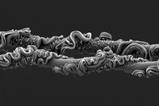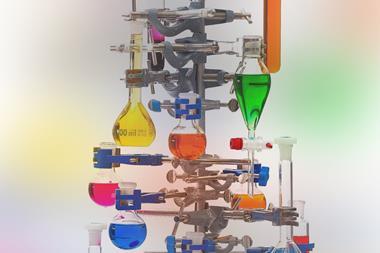Every year chemists at schools and universities around the world take part in what has become a Christmas tradition to brighten up classrooms and labs: they create Christmas trees out of chemical apparatus, also known as chemistrees. We’ve picked five of our favourites from this year.
1 First up Emmanuelle Ruelle and her students in France have created a colourful rainbow chemistree and if you look closely the students have also decorated it with silver-mirrored test tubes.
La version de ce matin des 1GA du Chemistree avec un miroir d'argent et le matériel du kit Yes we code de @Fond_CGenial adopté par les élèves avec une aisance déconcertante 🤩 pic.twitter.com/JyeV2OwHZ6
— ProfRuelle (@ProfRuelle) December 20, 2023
2 Year 12 students at Cheam High School in the UK took inspiration from this year’s Nobel prize in chemistry to create their chemistree. Their coloured glass round-bottomed flasks represent the effect of particle size on colours observed in quantum dots. If you want to learn more about quantum dots we’ve got an explainer on the topic.
Our STEAM Club's glowing purist #OChemistree #Chemistree celebrating the 2023 @NobelPrize in Chemistry. Designed by Yr 12 Colours to represent effect of nanodot size on blue light. They also made some coloured glass representing use in stained glass manufacturing. @OChemistree pic.twitter.com/OkOAYHXT2I
— Cheam High School (@cheamhigh) December 19, 2023
3 An eclectic chemistree from Chris Marsh at the University of Leicester features more silver-mirrored flasks and what appear to be impressive copper sulfate crystals.
It's that time of year - presenting to you the UoL Chemistree 2023! With thanks to @Beth_Thur and @sara_ycho for help 🎄 @uniofleicester @Leicesterchem pic.twitter.com/yqJ1YMurbV
— Chris Marsh (@cm_stoke) December 13, 2023
4 Jari Yli-Kauhaluoma at the University of Helsinki in Finland has created a sizeable (and bright) chemistree in his lab.
The Viikki Chemistree 2023🌲
— Jari Yli-Kauhaluoma (@JYK_Viikki) December 18, 2023
Happy Xmas!#FTDK #pharmacy #Biocenter2 #chemistree #Xmas #ViikkiCampus @LifeSciHelsinki @helsinkiuni pic.twitter.com/esBEQE6tZm
5 Our final chemistree was created by Andres Tretiakov, a science technician at St Paul’s School in the UK, who has done a clever bit of microwave chemistry to produce carbon nanodots. These carbon quantum dots glow under UV, something harnessed here to create an interesting display.
This micro synthesis is remarkably straightforward & the results glow 😉 using a standard UV torch 365nm. I could only get blue, green & yellowish about 2-20 nm dots in size but not other colours. The laser beam shows they are colloids. Safer & less toxic than other quantum dots pic.twitter.com/IDV2bXsv3F
— Andres Tretiakov (@Andrestrujado) December 12, 2023
John O’Donoghue at Trinity College, Dublin has also been running his annual chemistree competition. Check out his top picks for more festive chemistry.
Annnnd we have winners! Congrats to all the category winners and the runners up. It was a difficult theme to incorporate this year so well done! Huge congrats to @Andrestrujado who is our overall winner - it was a great #Chemistree!👏🧪 #ChemEd https://t.co/RjBk67gN9W
— OChemistree (@OChemistree) December 21, 2023
And finally…
Not a chemistree in the conventional sense but well worth an honourable mention. This team at Nanjing University in China created a system for 3D printing polylactic-co-glycolic acid microneedles that was then put to use creating a Christmas tree design. While the researchers’ 3D printing system can produce attractive designs, the reason they developed it was to produce cheap microneedle patches for drug delivery. The polymer the 3D printer deposits can be loaded with different drugs and vaccines and when a microneedle patch is applied to a person’s skin the needles deliver the drug painlessly.

















No comments yet